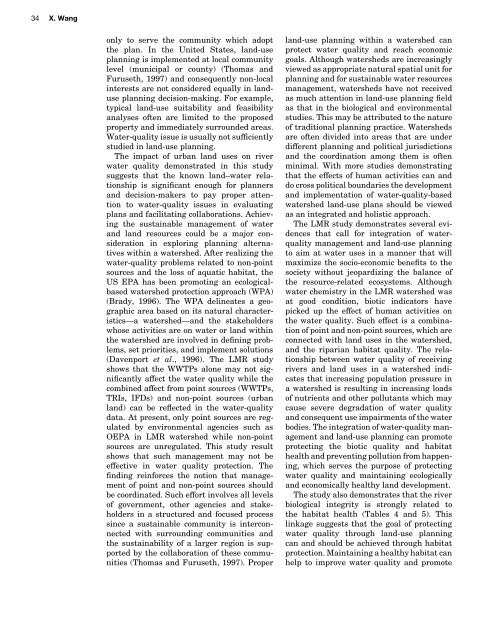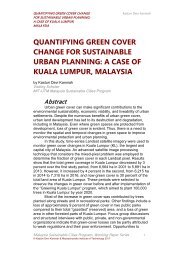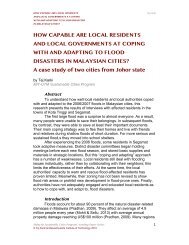Integrating water quality management & landuse planning in a watershed context
Create successful ePaper yourself
Turn your PDF publications into a flip-book with our unique Google optimized e-Paper software.
34 X. Wang<br />
only to serve the community which adopt<br />
the plan. In the United States, land-use<br />
<strong>plann<strong>in</strong>g</strong> is implemented at local community<br />
level (municipal or county) (Thomas and<br />
Furuseth, 1997) and consequently non-local<br />
<strong>in</strong>terests are not considered equally <strong>in</strong> <strong>landuse</strong><br />
<strong>plann<strong>in</strong>g</strong> decision-mak<strong>in</strong>g. For ex<strong>amp</strong>le,<br />
typical land-use suitability and feasibility<br />
analyses often are limited to the proposed<br />
property and immediately surrounded areas.<br />
Water-<strong>quality</strong> issue is usually not sufficiently<br />
studied <strong>in</strong> land-use <strong>plann<strong>in</strong>g</strong>.<br />
The impact of urban land uses on river<br />
<strong>water</strong> <strong>quality</strong> demonstrated <strong>in</strong> this study<br />
suggests that the known land–<strong>water</strong> relationship<br />
is significant enough for planners<br />
and decision-makers to pay proper attention<br />
to <strong>water</strong>-<strong>quality</strong> issues <strong>in</strong> evaluat<strong>in</strong>g<br />
plans and facilitat<strong>in</strong>g collaborations. Achiev<strong>in</strong>g<br />
the susta<strong>in</strong>able <strong>management</strong> of <strong>water</strong><br />
and land resources could be a major consideration<br />
<strong>in</strong> explor<strong>in</strong>g <strong>plann<strong>in</strong>g</strong> alternatives<br />
with<strong>in</strong> a <strong>water</strong>shed. After realiz<strong>in</strong>g the<br />
<strong>water</strong>-<strong>quality</strong> problems related to non-po<strong>in</strong>t<br />
sources and the loss of aquatic habitat, the<br />
US EPA has been promot<strong>in</strong>g an ecologicalbased<br />
<strong>water</strong>shed protection approach (WPA)<br />
(Brady, 1996). The WPA del<strong>in</strong>eates a geographic<br />
area based on its natural characteristics—a<br />
<strong>water</strong>shed—and the stakeholders<br />
whose activities are on <strong>water</strong> or land with<strong>in</strong><br />
the <strong>water</strong>shed are <strong>in</strong>volved <strong>in</strong> def<strong>in</strong><strong>in</strong>g problems,<br />
set priorities, and implement solutions<br />
(Davenport et al., 1996). The LMR study<br />
shows that the WWTPs alone may not significantly<br />
affect the <strong>water</strong> <strong>quality</strong> while the<br />
comb<strong>in</strong>ed affect from po<strong>in</strong>t sources (WWTPs,<br />
TRIs, IFDs) and non-po<strong>in</strong>t sources (urban<br />
land) can be reflected <strong>in</strong> the <strong>water</strong>-<strong>quality</strong><br />
data. At present, only po<strong>in</strong>t sources are regulated<br />
by environmental agencies such as<br />
OEPA <strong>in</strong> LMR <strong>water</strong>shed while non-po<strong>in</strong>t<br />
sources are unregulated. This study result<br />
shows that such <strong>management</strong> may not be<br />
effective <strong>in</strong> <strong>water</strong> <strong>quality</strong> protection. The<br />
f<strong>in</strong>d<strong>in</strong>g re<strong>in</strong>forces the notion that <strong>management</strong><br />
of po<strong>in</strong>t and non-po<strong>in</strong>t sources should<br />
be coord<strong>in</strong>ated. Such effort <strong>in</strong>volves all levels<br />
of government, other agencies and stakeholders<br />
<strong>in</strong> a structured and focused process<br />
s<strong>in</strong>ce a susta<strong>in</strong>able community is <strong>in</strong>terconnected<br />
with surround<strong>in</strong>g communities and<br />
the susta<strong>in</strong>ability of a larger region is supported<br />
by the collaboration of these communities<br />
(Thomas and Furuseth, 1997). Proper<br />
land-use <strong>plann<strong>in</strong>g</strong> with<strong>in</strong> a <strong>water</strong>shed can<br />
protect <strong>water</strong> <strong>quality</strong> and reach economic<br />
goals. Although <strong>water</strong>sheds are <strong>in</strong>creas<strong>in</strong>gly<br />
viewed as appropriate natural spatial unit for<br />
<strong>plann<strong>in</strong>g</strong> and for susta<strong>in</strong>able <strong>water</strong> resources<br />
<strong>management</strong>, <strong>water</strong>sheds have not received<br />
as much attention <strong>in</strong> land-use <strong>plann<strong>in</strong>g</strong> field<br />
as that <strong>in</strong> the biological and environmental<br />
studies. This may be attributed to the nature<br />
of traditional <strong>plann<strong>in</strong>g</strong> practice. Watersheds<br />
are often divided <strong>in</strong>to areas that are under<br />
different <strong>plann<strong>in</strong>g</strong> and political jurisdictions<br />
and the coord<strong>in</strong>ation among them is often<br />
m<strong>in</strong>imal. With more studies demonstrat<strong>in</strong>g<br />
that the effects of human activities can and<br />
do cross political boundaries the development<br />
and implementation of <strong>water</strong>-<strong>quality</strong>-based<br />
<strong>water</strong>shed land-use plans should be viewed<br />
as an <strong>in</strong>tegrated and holistic approach.<br />
The LMR study demonstrates several evidences<br />
that call for <strong>in</strong>tegration of <strong>water</strong><strong>quality</strong><br />
<strong>management</strong> and land-use <strong>plann<strong>in</strong>g</strong><br />
to aim at <strong>water</strong> uses <strong>in</strong> a manner that will<br />
maximize the socio-economic benefits to the<br />
society without jeopardiz<strong>in</strong>g the balance of<br />
the resource-related ecosystems. Although<br />
<strong>water</strong> chemistry <strong>in</strong> the LMR <strong>water</strong>shed was<br />
at good condition, biotic <strong>in</strong>dicators have<br />
picked up the effect of human activities on<br />
the <strong>water</strong> <strong>quality</strong>. Such effect is a comb<strong>in</strong>ation<br />
of po<strong>in</strong>t and non-po<strong>in</strong>t sources, which are<br />
connected with land uses <strong>in</strong> the <strong>water</strong>shed,<br />
and the riparian habitat <strong>quality</strong>. The relationship<br />
between <strong>water</strong> <strong>quality</strong> of receiv<strong>in</strong>g<br />
rivers and land uses <strong>in</strong> a <strong>water</strong>shed <strong>in</strong>dicates<br />
that <strong>in</strong>creas<strong>in</strong>g population pressure <strong>in</strong><br />
a <strong>water</strong>shed is result<strong>in</strong>g <strong>in</strong> <strong>in</strong>creas<strong>in</strong>g loads<br />
of nutrients and other pollutants which may<br />
cause severe degradation of <strong>water</strong> <strong>quality</strong><br />
and consequent use impairments of the <strong>water</strong><br />
bodies. The <strong>in</strong>tegration of <strong>water</strong>-<strong>quality</strong> <strong>management</strong><br />
and land-use <strong>plann<strong>in</strong>g</strong> can promote<br />
protect<strong>in</strong>g the biotic <strong>quality</strong> and habitat<br />
health and prevent<strong>in</strong>g pollution from happen<strong>in</strong>g,<br />
which serves the purpose of protect<strong>in</strong>g<br />
<strong>water</strong> <strong>quality</strong> and ma<strong>in</strong>ta<strong>in</strong><strong>in</strong>g ecologically<br />
and economically healthy land development.<br />
The study also demonstrates that the river<br />
biological <strong>in</strong>tegrity is strongly related to<br />
the habitat health (Tables 4 and 5). This<br />
l<strong>in</strong>kage suggests that the goal of protect<strong>in</strong>g<br />
<strong>water</strong> <strong>quality</strong> through land-use <strong>plann<strong>in</strong>g</strong><br />
can and should be achieved through habitat<br />
protection. Ma<strong>in</strong>ta<strong>in</strong><strong>in</strong>g a healthy habitat can<br />
help to improve <strong>water</strong> <strong>quality</strong> and promote






